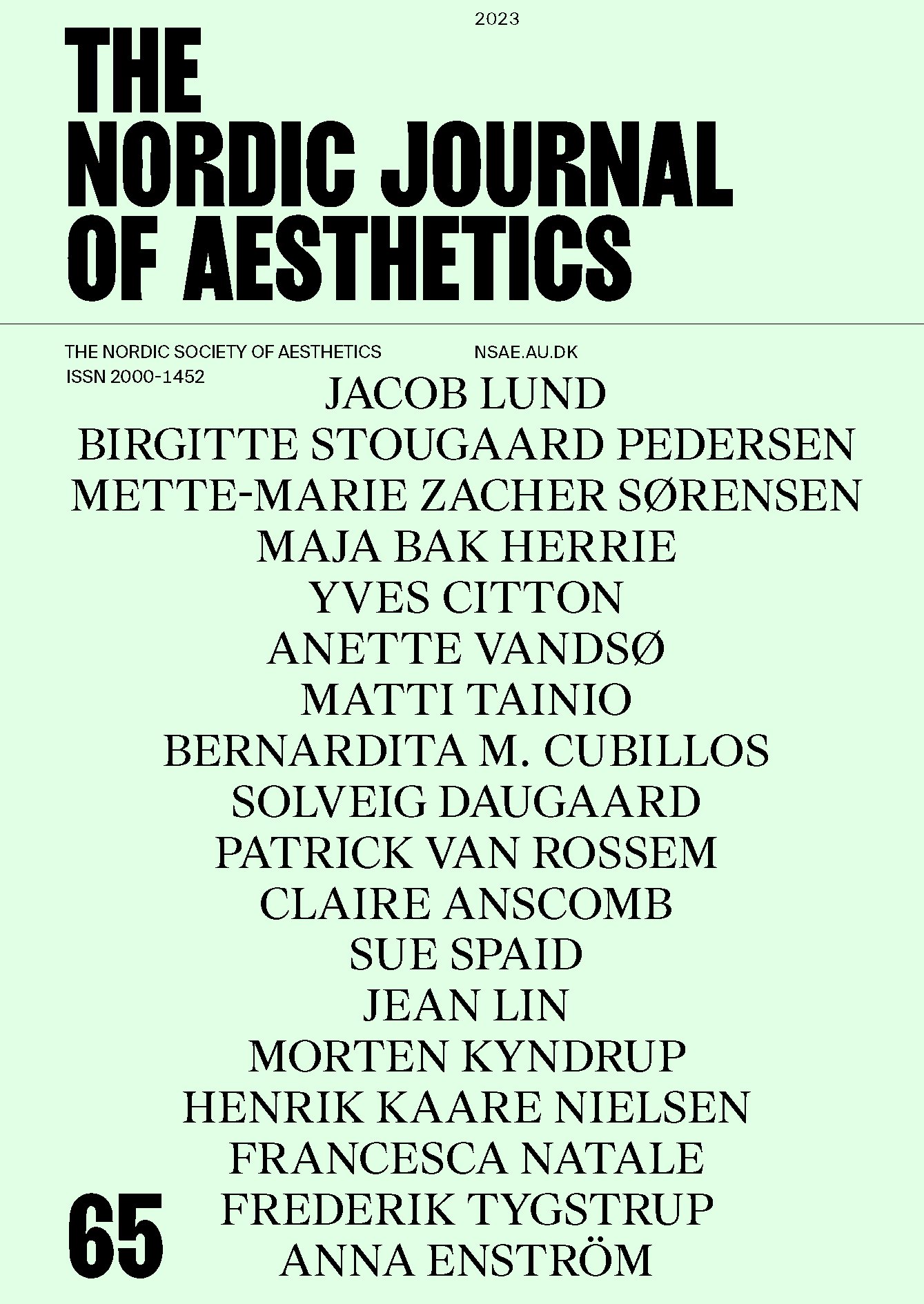Attention and Aesthetic Value
DOI:
https://doi.org/10.7146/nja.v32i65-66.140111Keywords:
Attention, Autonomy, Poiesis versus Aesthesis, KantAbstract
We are capable of engaging in different kinds of relations with objects and situations we meet. Any relation is, in principle singular and thus einmalig, unique. Still, certain general types of relationality do exist. Relations may be established with focus (“attention”) on usability, truth, ethics, power, authenticity—and of course, on “beauty,” on aesthetic value. This differentiation is an invention of the Modern world and in itself subject to historical change. In terms of “discursive areas” it has been theorized in varying keys—including quite many universalist ones. We are free to choose our modes of attention. Still, institutionalized discourses in practice pre-configure these modes. Especially when it comes to art and Modernity’s “great divide” between poiesis and aesthesis, the conditions for attentional approaches appear largely pre-figured. The article discusses this pre-configuration and the institutionalized “freedoms” of art and its audience, respectively—including current calls to abolish such differentiations and to transgress the discursive boundaries of art.
References
Jacques Rancière, Aisthesis. Scènes du régime esthétique de l’art (Paris: Galilée, 2011).
Morten Kyndrup, “Art, Aesthetics–Divorce?,” Site, no. 33 (2013); “Ästhetik, Kunst und Kunstverstandnis. Die Kunst und das
Kunstwerk,” Neue Rundschau Heft 1 (2012).
Jean-Marie Schaeffer, L’Art de l’âge moderne (Paris: Gallimard, 1992).
Thierry de Duve, Kant after Duchamp (Cambridge, MA: MIT, 1996).
Thierry de Duve, Aesthetics at Large: Art, Ethics, Politics (Chicago: University of Chicago Press, 2018).
Peter Bürger, Theorie der Avantgarde (Frankfurt am M.: Suhrkamp, 1974).
Carole Talon-Hugon, L’art sous contrôle. Nouvel agenda societal et censures militantes (Paris: PUF, 2019).
David Lloyd, Under Representation: The Racial Regime of Aesthetics (New York: Fordham UP, 2019).
Juliane Rebentisch, Theorien der Gegenwartskunst–zur Einführung (Hamburg: Junius, 2013).
Gérard Genette, L’oeuvre de l’art**. La relation esthétique (Paris: Seuil, 1997).
Thierry de Duve, “Why Kant got it right,” in Æstetisering. Forbindelser og forskelle, edited by Birgit Eriksson, Jacob Lund, Henrik Kaare Nielsen & Birgitte Stougaard Pedersen (Aarhus: Klim, 2012)
Morten Kyndrup, “Aesthetics and Judgment: ‘Why Kant Got It Right’”, Nordic Journal of Aesthetics, no. 54 (2018): 75–85.
Downloads
Published
How to Cite
Issue
Section
License
Copyright (c) 2023 Morten Kyndrup

This work is licensed under a Creative Commons Attribution 4.0 International License.
Authors who publish with this journal agree to the following terms:
- Authors retain copyright and grant the journal right of first publication with the work simultaneously licensed under a Creative Commons Attribution License that allows others to share the work with an acknowledgement of the work's authorship and initial publication in this journal.
- Authors are able to enter into separate, additional contractual arrangements for the non-exclusive distribution of the journal's published version of the work (e.g., post it to an institutional repository or publish it in a book), with an acknowledgement of its initial publication in this journal.
- Authors are permitted and encouraged to post their work online (e.g., in institutional repositories or on their website) prior to and during the submission process, as it can lead to productive exchanges, as well as earlier and greater citation of published work (See The Effect of Open Access).




